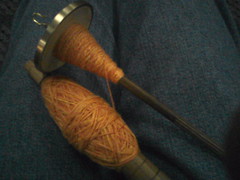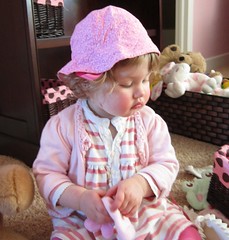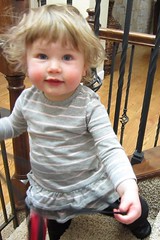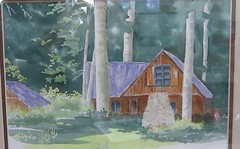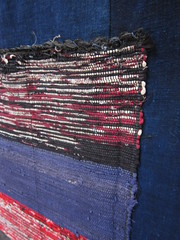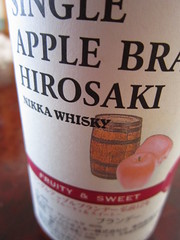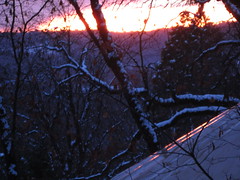Record Keeping
Rachel asked online about note-taking, record keeping and samples: how do you organize your notes and samples or do you even take/keep any?
I keep both weaving records and fabric samples. I don't keep much record of knitting projects, nor of spinning, except to note a breed (if applicable) when I am using handspun yarns. The samples show me enough to determine a grist, and the record sheets tell me the sett, the width of fabric on the loom, the weft, and the length of the warp.
I may have missed a few things over the years, but I have notebooks of weaving records going back to 1982 (OK, that's 6 years after I learned to weave). I was weaving a lot prior to 1982, and I have pieces of paper with notations on them, but they are not dated. I stuck them in the binder from 1982 onward:
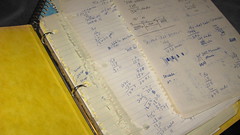
How detailed are these notes? Not very. They usually tell me the yarns, warp and weft, the project I was planning, the sett, how long the warp is, maybe the date (later notes always have the date):
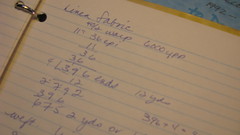
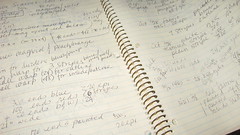
Have they been useful? Boy Howdy (that means yes). I started teaching people to spin in 1980, at a local yarn store. I've taught weaving, and later dyeing, and nowadays even though the course title might be XXXX it includes a bit of everything I do. So yes, the records have come in handy, if only to help me identify yarns and setts in the samples I bring with me:
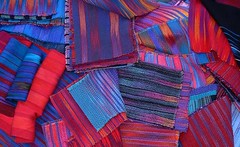
I used to bring lots of fabrics and garments to classes, but that became unwieldy the further afield I traveled. So, I created sample books:
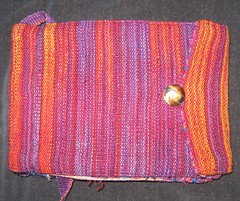
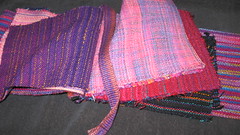
This one is indeed a book, with pages bound together, a cover, a button closure, and a book mark!
Later I got lazy, and just sewed the ends together into signatures, and bound several signatures into booklets, no covers:
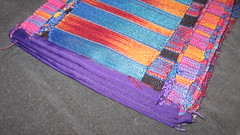
These are certainly simple, and I managed to corral many samples into a backpack-size travel bundle:

People can handle and examine the fabrics, although it's a little hard to determine drape from such a small piece (these are anywhere from 5" x 7" to 14" x 20"). More recently, I have gotten yet more slothful:
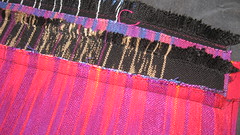
I just sew the edges of several pieces of fabric together....not even any nice ribbon covers. But they are still useful, and easy to travel with, show, pass around, and store in the studio.
I have had occasion recently to refer to my weaving notes over and over and over again. I'm writing a second book, this time on spinning to weave. Lots and lots and lots of my projects over the years have been handspun and handwoven, so the notes will help me speak accurately about the samples or finished projects that eventually end up in the book. There are new projects of course (which is much the reason this blog has been so vague this year), but even with those, I could refer to my notes if, for example I were to make a new handspun silk kimono (ahem) to find out the width of fabric I used before.
You never know where this spinning/weaving/knitting/dyeing stuff will end up, so yes, I'd say keep records. Even if they are as vague as mine, they just might come in handy. They don't have to be fancy (see above) or even very complete, as long as it gives you enough information to speak accurately about your project, 20 years from now (or thereabouts)!
And to answer a blog question from my last post, Cynthia asked about my spindle plying from a ball on the nostepinne:
Are you plying from the inside & outside together?
No: I run the cops from two spindles together onto the nostepinne:
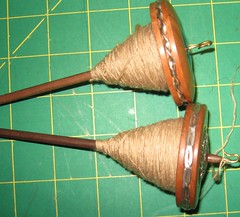
And then ply from that...essentially the two singles are wound together, and the plying involves just adding twist:
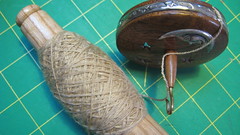
And finally, to bring everything full circle, talk about saving things: here is someone I love very much sitting in my father's rocking chair. She is a model circa 2010, and the chair is from 1915:

And yes, I bought her the duds! :)
I keep both weaving records and fabric samples. I don't keep much record of knitting projects, nor of spinning, except to note a breed (if applicable) when I am using handspun yarns. The samples show me enough to determine a grist, and the record sheets tell me the sett, the width of fabric on the loom, the weft, and the length of the warp.
I may have missed a few things over the years, but I have notebooks of weaving records going back to 1982 (OK, that's 6 years after I learned to weave). I was weaving a lot prior to 1982, and I have pieces of paper with notations on them, but they are not dated. I stuck them in the binder from 1982 onward:

How detailed are these notes? Not very. They usually tell me the yarns, warp and weft, the project I was planning, the sett, how long the warp is, maybe the date (later notes always have the date):


Have they been useful? Boy Howdy (that means yes). I started teaching people to spin in 1980, at a local yarn store. I've taught weaving, and later dyeing, and nowadays even though the course title might be XXXX it includes a bit of everything I do. So yes, the records have come in handy, if only to help me identify yarns and setts in the samples I bring with me:

I used to bring lots of fabrics and garments to classes, but that became unwieldy the further afield I traveled. So, I created sample books:


This one is indeed a book, with pages bound together, a cover, a button closure, and a book mark!
Later I got lazy, and just sewed the ends together into signatures, and bound several signatures into booklets, no covers:

These are certainly simple, and I managed to corral many samples into a backpack-size travel bundle:

People can handle and examine the fabrics, although it's a little hard to determine drape from such a small piece (these are anywhere from 5" x 7" to 14" x 20"). More recently, I have gotten yet more slothful:

I just sew the edges of several pieces of fabric together....not even any nice ribbon covers. But they are still useful, and easy to travel with, show, pass around, and store in the studio.
I have had occasion recently to refer to my weaving notes over and over and over again. I'm writing a second book, this time on spinning to weave. Lots and lots and lots of my projects over the years have been handspun and handwoven, so the notes will help me speak accurately about the samples or finished projects that eventually end up in the book. There are new projects of course (which is much the reason this blog has been so vague this year), but even with those, I could refer to my notes if, for example I were to make a new handspun silk kimono (ahem) to find out the width of fabric I used before.
You never know where this spinning/weaving/knitting/dyeing stuff will end up, so yes, I'd say keep records. Even if they are as vague as mine, they just might come in handy. They don't have to be fancy (see above) or even very complete, as long as it gives you enough information to speak accurately about your project, 20 years from now (or thereabouts)!
And to answer a blog question from my last post, Cynthia asked about my spindle plying from a ball on the nostepinne:
Are you plying from the inside & outside together?
No: I run the cops from two spindles together onto the nostepinne:

And then ply from that...essentially the two singles are wound together, and the plying involves just adding twist:

And finally, to bring everything full circle, talk about saving things: here is someone I love very much sitting in my father's rocking chair. She is a model circa 2010, and the chair is from 1915:

And yes, I bought her the duds! :)
